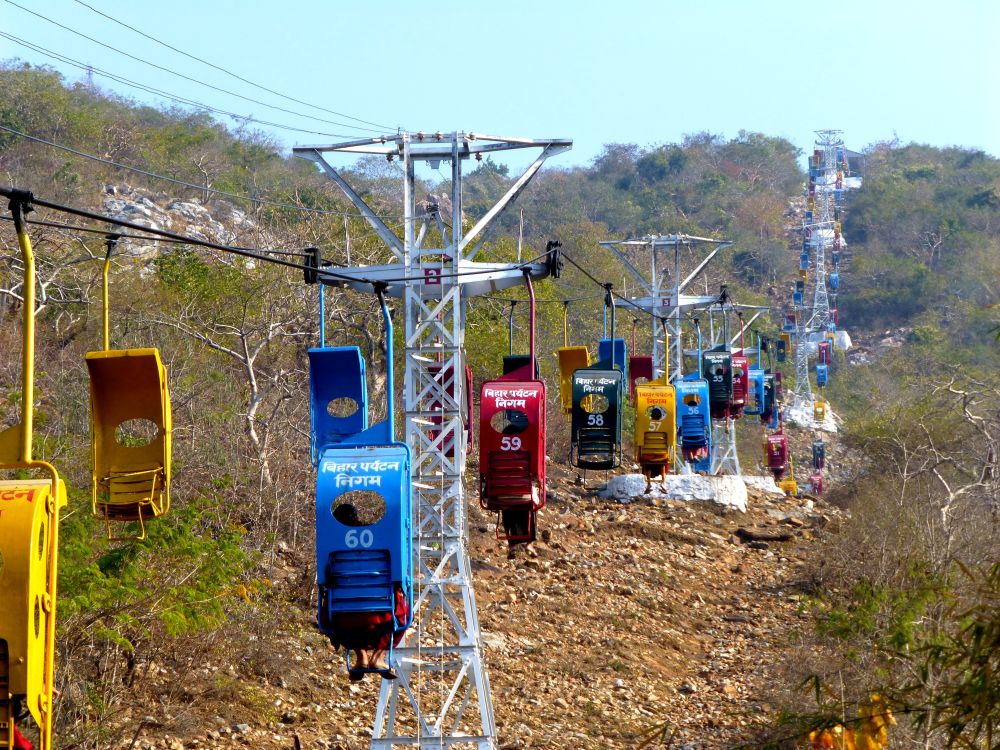

The Rajgir Ropeway, also known as the Rajgir Chairlift, is one of the foremost attractions in the ancient city of Rajgir, located in the Nalanda district of Bihar, India. The ropeway holds the distinction of being the oldest ropeway system in India. Established in the 1960s, the Rajgir Ropeway has been serving tourists and pilgrims for decades, providing a scenic and convenient route to the venerated Shanti Stupa, atop the Ratnagiri Hill.
Rajgir, historically known as Rajagriha, was the first capital of the kingdom of Magadha, a state that would eventually evolve into the Mauryan Empire. It is a place of great sanctity and significance for both Buddhists and Jains, as it is associated with Lord Buddha and Lord Mahavira's life and teachings. Tourism in Rajgir is closely linked to these religious and historical facets. The region has seen visitors since the time of Buddha, making it one of the earliest known tourist destinations in India.
The construction of the Rajgir Ropeway was primarily motivated by the need to facilitate access to the Shanti Stupa atop Ratnagiri Hill. Before the ropeway's inception, pilgrims had to undertake an arduous trek to reach the shrine. With the establishment of the chairlift, visitors could now reach the Stupa quickly and without much strain.
Despite its age, it wasn't until the advent of broader tourism development in Bihar that the Rajgir Ropeway started gaining widespread attention. The chairlift's old-world charm and the panoramic views it offers have made it a popular tourist activity in Rajgir.
The Rajgir Ropeway is a single chairlift system, and riding it provides a unique and thrilling experience, with aerial views of the lush greenery and the historic ruins of Rajgir. It is particularly popular among those who come to visit the Peace Pagoda, or Shanti Stupa, which was built by a Japanese Buddhist organization. The Stupa is a symbol of peace and tranqulility, and stands as a testament to Rajgir's significance in Buddhist history.
In recent years, the government has initiated plans to boost tourism in Rajgir. In line with the latest tourism trends focusing on infrastructure improvements and sustainable tourism practices, the government has planned to implement modern ropeway technologies to enhance the safety and capacity of the Rajgir Ropeway. Additionally, resort-style accommodation and the development of theme parks have been proposed to attract a wider range of visitors.
The region around Rajgir is being developed as an "International Tourist Circuit", with improved road connectivity, better facilities, and promotion of the area's natural and archaeological heritage, leading to an increased footprint of both domestic and international tourists.
With increased tourism, there arises a challenge to maintain the delicate balance between facilitating visitor access and preserving the natural environment and historical significance of Rajgir. Authorities are continuously working to ensure that the growth in tourism doesn't come at the cost of Rajgir's ancient heritage, and that the ropeway continues to serve as a sustainable passage to the serenity of the Shanti Stupa.
The Rajgir Ropeway remains a prime example of how historical attractions can be blended with modern amenities to boost tourism, without detracting from the cultural essence of the destination. As one of the iconic elements of Rajgir's tourism scene, the Chairlift to Shanti Stupa continues to be a much-loved attraction, offering a journey that is as much about the destination as it is about the experience of getting there.